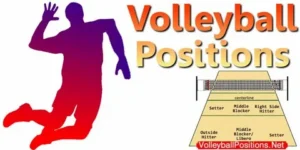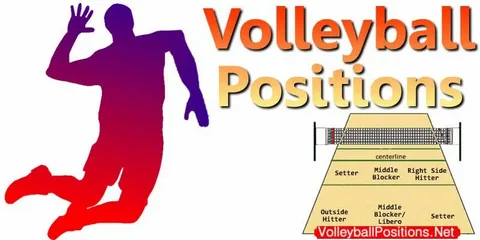Volleyball Positions: Understanding the Key Roles on the Court

Volleyball is a fast-paced sport that requires coordination, strategy, and a strong understanding of the game. At the heart of a well-functioning volleyball team is the understanding of volleyball positions. Each position has a unique role, contributing to the overall success of the team. Whether you’re a newbie trying to learn the basics or an experienced player brushing up on your knowledge, understanding the specific volleyball positions will give you a much better grasp of the game.
In this article, we’ll break down each volleyball position in detail, explaining the responsibilities of each role, what makes them crucial to a team’s performance, and how players in each position interact with one another. So, let’s dive in!
1. Outside Hitter (Left Side Hitter)
Overview
The outside hitter (also known as the left-side hitter) is often considered one of the most crucial positions on the court. This player is responsible for attacking the ball from the front left side of the court, and they are frequently the primary attacker.
Key Responsibilities:
Attacking: They play a significant role in offensive plays, attempting to score points by spiking the ball over the net.
Passing: Outside hitters need to be excellent at passing during serve receive, often taking on the responsibility of receiving the ball from the opposing team’s serve.
Defense: They also contribute defensively, especially by digging (receiving) attacks from the opponent’s hitters.
Blocking: While not their primary role, outside hitters must be able to block opposing attackers from the front row.
Skills Needed:
Strong spiking ability.
Quick reflexes for defense.
Good communication with teammates for coordinating plays.
2. Right Side Hitter (Opposite)
Overview
The right-side hitter (also called the opposite) plays on the right side of the court, directly opposite the outside hitter. This player’s primary role is to provide additional offense while also supporting the defense.
Key Responsibilities:
Offense: Like the outside hitter, the right-side hitter is a key attacker, often having to face the opposing team’s best blockers.
Defense: This position is critical in blocking attacks, especially against the opposing outside hitters.
Serving: The right-side hitter may also serve at times, depending on the rotation.
Skills Needed:
Strong blocking skills.
Effective attacking from different angles.
Ability to perform under pressure, especially against tough opponents.
3. Setter
Overview
The setter is often described as the quarterback of the team. They are in charge of setting up offensive plays by delivering accurate sets to the hitters. A great setter can completely change the dynamic of the game.
Key Responsibilities:
Setting: The setter’s primary job is to set the ball up for an attacker. They need to have a precise and quick hand-set.
Decision Making: The setter must decide who to set the ball to based on the opposing defense and team strengths.
Defense: The setter plays a defensive role when they are in the back row, often passing and digging balls.
Skills Needed:
Excellent hand-eye coordination.
Strong court awareness to read the defense and set up plays.
Quick thinking and adaptability.
4. Libero
Overview
The libero is a specialized defensive player who cannot attack the ball above the net’s height. They are often regarded as the team’s best passer, and their job is to receive serves and play in the back row.
Key Responsibilities:
Passing: The libero is responsible for receiving serves and plays a major role in passing the ball accurately to the setter.
Digging: Their role also includes digging (defending) attacks from the opponent’s hitters, especially the hard-driven spikes.
Communication: Since they are often in the back row, liberos communicate with teammates about defensive plays.
Skills Needed:
Exceptional passing and defensive skills.
Fast reflexes.
Strong understanding of positioning.
5. Defensive Specialist (DS)
Overview
A defensive specialist is similar to the libero but does not have the same restrictions. They are typically used to strengthen the team’s defense in the back row.
Key Responsibilities:
Defending: Like the libero, the defensive specialist’s primary job is to pass and dig the ball, ensuring that the opponent’s attacks are handled efficiently.
Serve Receive: Defensive specialists often take a role in serve receive, supporting the setter and ensuring good passes.
Occasional Serving: Defensive specialists can serve and may do so during a game if needed.
Skills Needed:
Great defensive ability.
Agility and speed.
Reliable passing skills.
6. Middle Blocker (Middle Hitter)
Overview
The middle blocker, or middle hitter, plays a key role in defense. This player is positioned at the net and focuses on blocking opposing attacks, particularly those from the outside and right-side hitters.
Key Responsibilities:
Blocking: Middle blockers must be quick on their feet, reading the opposing hitters and jumping at the right time to block attacks.
Offense: In addition to blocking, they are key offensive players, often running quick attacks called “quick sets.”
Transition: Middle blockers must quickly transition between offense and defense, ensuring they are in the right place at the right time.
Skills Needed:
Strong blocking technique.
Quick reflexes.
Timing for attacking and blocking.
7. Team Coordination and Communication
The Importance of Communication
No matter what position you play, communication is critical in volleyball. Players must constantly talk to one another, whether it’s calling for the ball, signaling plays, or encouraging teammates. A lack of communication can lead to confusion and missed opportunities.
Effective Teamwork
Understanding volleyball positions is not enough by itself. A team that works together cohesively will always outperform one that lacks coordination, regardless of how skilled individual players are. Great teams communicate well and work in sync, covering each other’s weaknesses and playing to their strengths.
8. Volleyball Positions in Action: How They Work Together
Each volleyball position depends on the others to function. A strong outside hitter can’t be successful without a good setter, and a great libero can only do so much if the blockers aren’t doing their part. Volleyball is a team sport, and every role, no matter how specialized, is crucial to the team’s success.
FAQs:
1. What is the most important position in volleyball?
While all positions are essential, the setter is often considered the most critical because they control the ball’s flow and create offensive opportunities for the team.
2. Can a libero ever attack the ball?
No, liberos are not allowed to attack the ball above the net’s height. Their primary job is defense and passing.
3. What’s the difference between a middle blocker and an outside hitter?
Middle blockers focus on blocking attacks and quick offensive plays at the net, while outside hitters are the primary attackers on the team, often spiking the ball from the front row.
4. What does the right-side hitter do?
The right-side hitter’s primary role is to attack the ball, but they also play a significant defensive role by blocking and assisting with passing.
5. Can a defensive specialist serve?
Yes, defensive specialists can serve and may do so during the game, depending on the team’s rotation.
9. Conclusion
In volleyball, every position plays a significant role. Whether it’s the outside hitter spiking the ball, the setter setting up the play, or the libero digging attacks, each player’s contribution is essential. Understanding volleyball positions not only helps players find their strengths but also ensures teams can perform at their best by maximizing their strengths and covering for any weaknesses.
When you know your position inside and out, and how it fits within the team’s strategy, you can elevate your game and help lead your team to victory. Embrace the role you play, communicate with your teammates, and enjoy the dynamics that make volleyball such an exciting and fast-paced sport!
